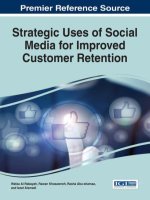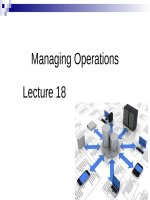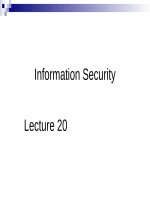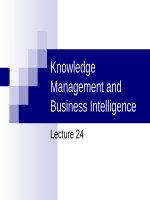Lecture Business management information system - Lecture 8: Strategic uses of information technology
Bạn đang xem bản rút gọn của tài liệu. Xem và tải ngay bản đầy đủ của tài liệu tại đây (894.36 KB, 55 trang )
Strategic Uses of Information
Technology
Lecture 8
Today Lecture Summary
¨ Episode
n
Two: Profitability Strikes Back
¨ Does IT Still Matter?
Working Inward: Business-to-Employee
¨ Building an Intranet
¨ Fostering a Sense of Belonging
Introduction
Episode Two: Profitability Strikes Back
n
Dot-coms became dot-bombs (dot-cons?) because they
couldn’t generate profits
n
Episode One: The Dot-Com Menace
n
Episode Two: Profitability Strikes Back
¨
Whilst it has taken these so-called “old economy firms” longer to
utilize the Web they realize that they must do so in a profitmaking manner
Introduction
Episode Two: Profitability Strikes Back
n
Use the Internet to complement your strategy, not
replace your past way of serving customers nor
disintermediate your channels
¨
Michael Porter, Harvard Business Scho
GRAINGER
Case example: Using the Internet to complement your strategy
n
Distributes non-production products to companies
through stocking locations all over the U.S.
¨ Customers
who purchase on their website also
purchase through traditional channels
n
Physical sites make its online presence more
valuable
GRAINGER
Case example: Using the Internet to
complement your strategy conti..
Customers who want fast delivery
n Ordering is less expensive and shipping is cheaper
in bulk to stocking locations Vs. individual small
shipments
¨ Continue publishing its paper catalogs
n It receives a surge of online orders every time it
issues its paper catalog
q
Introduction
Definitions
n
n
n
n
‘e’ = electronic
e-business
¨ Conducting business using telecommunications
networks esp. Internet
¨ Involves more than buying and selling
e-commerce
¨ Conducting commerce (buying and selling)
electronically using the Internet
Note: IT definitions ‘evolve’
E-Business Drivers
n
n
Key Components that have accelerated the rapid growth
and acceptance of e-business:
–
Wide access to a public network
–
Standard communication protocol
–
Standard user interface
E-business applications run over the Internet, drastically
reducing access and communications costs
– Pre Internet – 95% of Fortune 500 used EDI Vs. 2% of
all U.S. companies
E-Business Drivers
n
With standardized communication protocols and user
interfaces, implementation and training costs are far
lower
n
As a result, a much broader set of users and firms has
access to the systems, allowing rapid growth
Does IT Still Matter?
n
“IT Doesn’t Matter” – article by Nicholas Carr in
Harvard Business Review May 2003
¨ Controversial
and now a book
¨ Bottom
line = IT doesn’t matter anymore, at least
not strategically
n
IT is an infrastructure technology, like rail,
electricity, telephone etc.
Does IT Still Matter?
¨ Such
technology can create a strategic
advantage for an individual firm at the
beginning of its life cycle when it is expensive
and risky
n
Carr = IT is now at the end of buildout and is
neither proprietary or expensive
¨=
A commodity which is available to anyone
and won’t give any individual firm a competitive
advantage
Does IT Still Matter? cont.
n
Reached the end of its buildout:
1.
2.
3.
4.
5.
Power of IT now outstrips the needs of business
IT prices have dropped = now affordable
Capacity of Internet has caught up with demand (fibre
surplus)
Many vendors want to be seen as utilities
Investment bubble has burst
Does IT Still Matter? cont.
n
When an infrastructure technology reaches the end of
its buildout, it simply becomes a cost of doing business
n
Although IT is necessary for competitiveness,
Competitive advantage comes from the firm’s business
model
Does IT Still Matter? cont.
n
Management of IT should become “boring”
focussing on:
1.
Manage the risks
–
2.
Focus on vulnerabilities (which are more common with
open systems) rather than opportunities
Keep costs down
–
Greatest risk = overspending, so only pay for use and
limit upgrading
•
Don’t update PCs when not needed
Does IT Still Matter? cont.
3.
Stay behind the technology leaders
–
But not too far behind!
•
Delay investments until there are standards and best
practices and prices drop
•
Only innovate when risks are low
Does IT Still Matter? cont.
n
This ‘negative’ view deals with individual firms =
losing competitive advantage
n
Infrastructure technology brings its greatest
economic and social benefits to all once it has
become a shared infrastructure
¨
= what IT is becoming
Does IT Still Matter? cont.
n
The debate is on
¨
Many other views
¨
Is he right? Regardless = has prompted some important
discussions in Board Rooms etc. because executives need to
understand the underpinnings of IT to know how to guide it
n
IT is one of their strategic resources, besides people and $ for
working inward, outward and across
Working Inward: Business-to-Employee
Building an Intranet
n
The primary e-business way to reach employees is via
‘Intranets’
¨ Intranets
are private company networks that use
Internet technologies and protocols, and possibly the
Internet itself
n
Benefits of using intranets:
¨ Wider
access to company information
Working Inward: Business-to-Employee
Building an Intranet
¨ More
efficient and less expensive systems
development
¨ Decreased
¨ By
training (due to browser interface)
using an intranet’s open-system architecture,
companies can significantly decrease the cost of
providing companywide information and connectivity
Working Inward: Business-to-Employee
Building an Intranet cont.
n
Benefits cont.
–
Investments in a intranet (open) = significantly less $$ than a
proprietary network
–
The link to the Internet allows companies to expand intranets
worldwide easily and cheaply
§
Significant Benefit = unthinkable before the Internet!
Working Inward: Business-to-Employee
Building an Intranet cont.
¨
Because an intranet uses the browser interface (and internet
‘protocols’ /technology) = users do not need extensive training
on different products
§
¨
To a certain extent = applies to ‘all’ products today
Companies only need to record information in one place, where
it can be kept up-to-date for access by all employees no matter
where in the world they are located
WORKING INWARD: Business to
Employee
3-22
Working Inward: Business-to-Employee
Building an Intranet
n
Due to the ease with which Web sites can be created,
many employees have (did?) build their own, leading to a
proliferation of sites with company information
¨Deciding how much control of the systems should be
decentralized
Working Inward: Business-to-Employee
Building an Intranet
n Proposed solutions
¨Create a corporate portal to act as the gateway to the firm’s
internal resources, information, and Internet services
§
Microsoft, KPMG, Dell etc.
¨Develop separate departmental or divisional portals, such as
sales, HR, operations, and finance portals which are linked to
form a corporate portal
GE POWER SYSTEMS
Case example: Building an Intranet
n
Chairman surveyed sales force (2001)
¨ Found
they were spending more time in the office
searching for information than they were out with
their customers
n
GE Power Systems answered the challenge
by building a Web-based sales portal for its
sales-people









